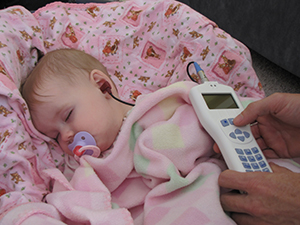No
Did you know?
Over 90% of babies born in Nebraska are screened with the A-ABR at birth. View and download a copy of what type of screening equipment is used at all birthing facilities in Nebraska so you know what type of screening was done inpatient.
Audiologist's Role in the Early Hearing Detection and Intervention Process
Audiologists determine whether a child is deaf or hard of hearing through screenings and diagnostic audiologic evaluations. Babies that do not pass their newborn hearing screening should have this evaluation no later than three months of age. Habilitation, including amplification if chosen, and initiation of Early Intervention services should occur no later than six months of age. These best practice guidelines are provided by the
Joint Committee on Infant Hearing (JCIH) in order to provide the best outcomes for children who are deaf or hard of hearing.
Best Practices
- Complete initial diagnostic evaluation, by 1 month of age if possible, using a battery of physiological tests.
- Report the results of diagnostic audiologic hearing evaluation to the child's primary care physician, including information that the infant was not successfully tested after being referred.
- Reports the names of all children who received a diagnostic evaluation, and those who are not successfully tested after being referred for a diagnostic evaluation to the NE-EHDI Program.
- Make a referral to the
Early Development Network (EDN) for children identified as deaf or hard of hearing, and report the date of referral to the NE-EHDI Program.
- Provide parents with information about hearing and childhood deafness, and communication and education options for children who are deaf or hard of hearing.
- Fit the child with amplification if chosen, including hearing aids or other assistive technology. Refer for consideration of cochlear implant candidacy when appropriate.
- Appropriate intervention, whether amplification and/or sign language immersion is chosen by the family and should be started
by 6 months of age, if possible.
The audiologist should conduct a
battery of tests that includes a case history, documentation of risk indicators for hearing loss, otoscopic inspection, evoked
Otoacoustic Emissions (OAE) assessment,
Auditory Brainstem Response (ABR) assessment, and middle ear measures.
The approach to services should be family-centered by promoting family and professional partnerships, responding to needs, building on strengths, and respecting the diversity of families.
The NE-EHDI Advisory Committee strongly recommends that any audiologist accepting infants younger than six months of age for audiologic assessment should follow best practice guidelines by having the ability to complete or refer to other pediatric audiology clinics with the capability to perform the following procedures:
Auditory Brainstem Response (ABR)
.jpg) Auditory Brainstem Response (ABR)
Auditory Brainstem Response (ABR) ABR threshold to frequency-specific stimuli for air and bone conduction.
ABR suprathreshold to click stimuli with varied rate and polarity.
Otoacoustic Emissions (OAE)
Transient-evoked (TEOAE) or distortion product (DPOAE) equipment is capable of a variety of test parameters.
 Otoacoustic Emissions (OAE)
Otoacoustic Emissions (OAE)
Acoustic Immittance
Tympanometry using probe tones greater than 226 Hz
Acoustic reflex threshold
Behavioral
Behavioral audiometric test procedures that are developmentally appropriate.
* An
otologic evaluation is also part of the assessment process but it may occur at a different facility and time.
The Audiologist should discuss the results with the family and report the audiologic assessment results to the infant's Primary Health Care Provider and the Nebraska Early Hearing Detection and Intervention Program. If permanent deafness in one or both ears is identified, regardless of degree and type, families should be given the Nebraska Early Hearing Detection and Intervention Program's Parent Resource Guide.
In line with JCIH guidelines, audiologists seeing infants should adhere to the following protocols to ensure the child is receiving the most comprehensive care:
- An infant who refers with an ABR
must be rescreened with an ABR screen
- An infant who refers in only one ear should have both ears rescreened
These are evidence-based guidelines that will help to identify most minimal deafness and auditory neuropathy cases present at birth.
- All outpatient screenings on newborns/infants
- Diagnostic results on children ages birth-3
- Late identifications on children ages birth-3
- Repeat screenings/evaluations due to risk factors for late-onset or progressive hearing loss.
- Behavioral Evaluations on children ages birth-3
- ENT evaluations on children ages birth-3 who have not passed their newborn hearing screening.
Nebraska Hands and Voices is dedicated to supporting families with children who are deaf or hard of hearing without a bias around communication modes or methods. They are a parent-driven, non-profit organization providing families with resources, networks, and information they need to improve communication access and educational outcomes for their children.
PTI Nebraska is a statewide resource for families of children with disabilities and special health care needs.
- PTI Nebraska's staff are parent/professionals and are available to talk to parents and professionals about special education, other services, and disability-specific information.
- PTI Nebraska conducts relevant, no-cost workshops statewide.
- PTI Nebraska provides printed and electronic resources.
- PTI Nebraska encourages and supports parents in leadership roles.
Relevant research articles: